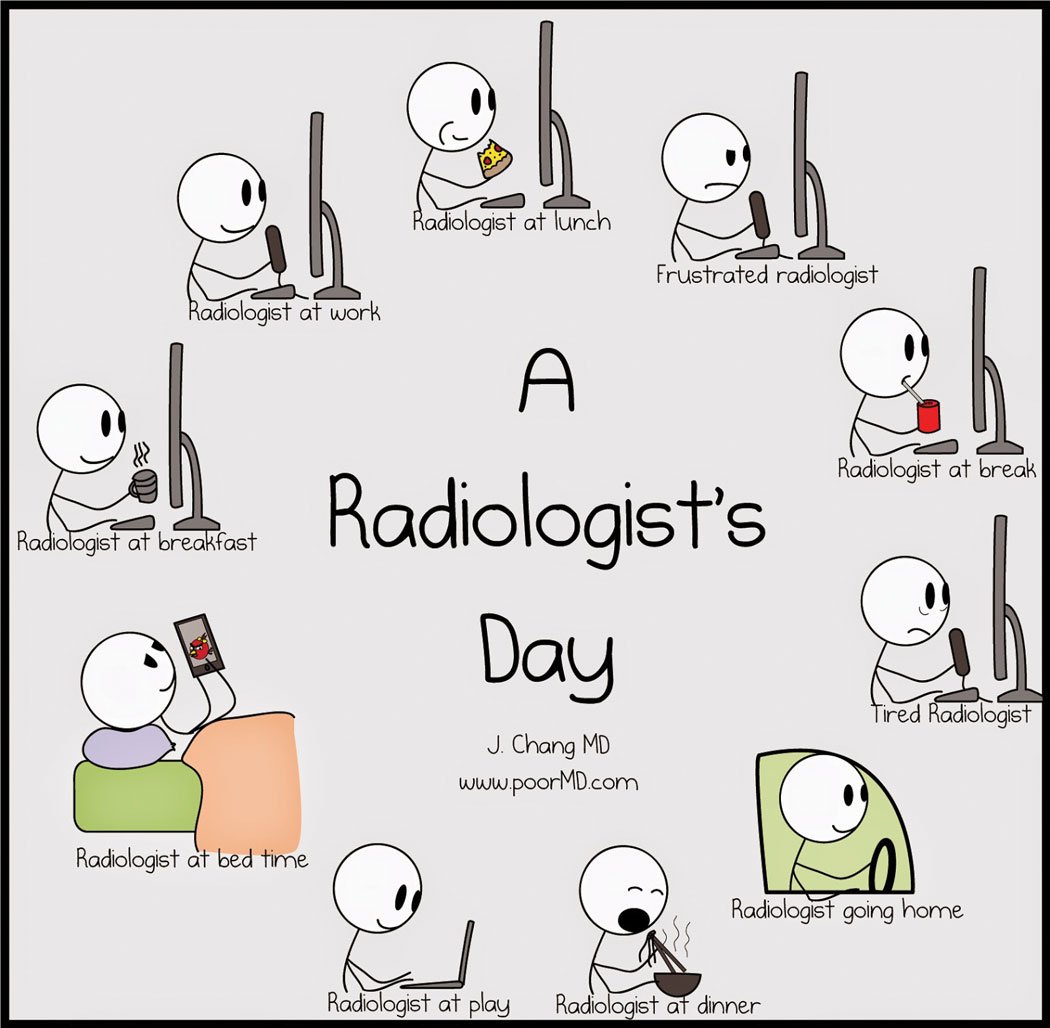
A series of drawings by radiologist James Chang, M.D., depicts the digital bombardment that he and his colleagues face daily. According to his website (www.poormd.com), Chang, who works with Radiology Imaging Associates of Englewood, Colo., loves to draw. More of his drawings can be found at www.facebook.com/poormd. Published with permission from James Chang.
Years ago in Vegas I came face-to-face with the strain of radiology. On-site, at an imaging practice built around managed care, I sat from 9 in the morning until 7 that night observing (as unobtrusively as possible) a radiologist. At day's end he retreated to his office, dragging me with him for a recap of the day, his eyes puffy and bloodshot.
Decades later I am beginning to feel a little of what that radiologist and others today must go through. Waxing
Clintonesque: I feel your strain.
Thanks to expanded RAM, low-cost flat screens and the wizardry of modern telecommunications, I simultaneously operate three desktop monitors, two tablets and a synched cell phone. Driven by beeps and dings, my eyes flit from one to the other, to my keyboard, to paper and, for a break, to my digital photo frame.
Typically by noon I am gingerly scraping precipitate from the corners of my eyes with the thumb and middle finger of my left hand.
Doing so provides a strange sense of accomplishment, like pulling the crumbled remnants of a leaf from the windshield wiper that was streaking more than clearing moisture from my windshield.
It should help, I think ... but the Cleveland Clinic doesn't say so. Instead the "Family Health Team" opines1 that I should:
- Adjust my viewing angle (the center of the monitor, tablet or phone should be 20 to 28 inches from my eyes and four to five inches below eye level);
- Reduce glare (too little contrast between letters and background or glare on the screen makes my eyes work harder);
- Rest my eyes (every 20 minutes, look away from my computer and at a distant object for 20 seconds);
- Blink (people normally blink about 18 times a minute, but computer users tend to blink only four to five); and
- Get my eyes checked (uncorrected vision problems can contribute to eyestrain and musculoskeletal pain).
The attention "computer vision syndrome" (CVS) has received (albeit limited) has come mostly from the growth of consumer electronics rather than the decades of digital reading endured by radiologists. Research into this problem from the radiologist's perspective is sparse, but unsettling.
In 2009 investigators from the University of Maryland and Aga Khan University Hospital in Karachi, Pakistan, found a statistically significant difference in visual acuity among radiologists that changed from morning to other times of the day.2 They concluded that the effect "was relatively modest and within previously published ranges of variability for similar visual acuity tests."
Another study however, published that same year, found that radiologists' eyestrain may have a more profound effect. Researchers at the Universities of Arizona and Iowa concluded that "because diagnostic image interpretation is performed at near viewing distances, (the) inability to maintain focus on the image could impact diagnostic accuracy."
Other than these two articles, information about eyestrain and its effects on radiologists and their performance is hard to find. Knowing the danger signs of CVS, at least, is a step in the right direction. Here are a few, according to WedMD:4
- Blurred vision
- Double vision
- Dry, red eyes
- Eye irritation
- Headaches
- Neck or back pain
Despite increasing radiology workloads in recent years, remarkably, there has been a dearth of research into the effects of eye fatigue on radiologists ... just as there has been little attention paid to alleviating this strain.
The need to look more closely at CVS, for radiologists as well as the increasingly digitally obsessed consumer, should be obvious.
Greg Freiherr has reported on developments in radiology since 1983. He runs the consulting service, The Freiherr Group. Read more of his views on his blog at www.itnonline.com.
References:
1.http://health.clevelandclinic.org/2013/09/5-fixes-computer-vision-syndrome/. Accessed June 4, 2015.
2. www.medscape.com/viewarticle/708589_4. Accessed June 4, 2015.
3. www.ncbi.nlm.nih.gov/pmc/articles/PMC2706933/. Accessed June 4, 2015.
4.www.webmd.com/eye-health/computer-vision-syndrome. Accessed
June 4, 2015.


 April 17, 2024
April 17, 2024 








